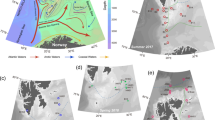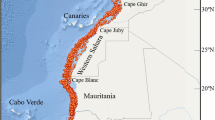Abstract
We examined deep-sea epibenthic sledge isopod data from the Atlantic sector of the Southern Ocean (SO) (depth range=742–5,191 m). Samples were taken during the expeditions EASIZ II (ANT XV-3) in 1998 and ANDEEP I and II (ANT XIX3/4) in 2002. A total of 471 isopod species were recorded from 28 sites. The species richness of the epibenthic sledge samples was highly variable (6–82 species). Species richness was highest at site 131-3 in 3,053 m depth in the north-eastern Weddell Sea. The highest numbers of species were sampled in the middle depth range and lower species richness was found in the shallower and deeper parts of the study area. Depth is suggested to explain isopod species richness better than both latitude and longitude. Between 58°S and 65°S, the number of species ranged from 9 to 82 (mean=35.9). Further south in the Weddell Sea, between 73°S and 74°S, species richness was lower and the number of species ranged from 6 to 35 (mean=19.2). With regard to longitude, the highest species richness (up to 82 species) was found between 50°W and 60°W in the area of the South Shetland Islands and around the Antarctic Peninsula, while numbers did not exceed 50 species in the eastern Weddell Sea. The haul length, ranging from 807 to 6,464 m, was positively correlated with depth; however, there was no linear relationship between haul length and species richness. We therefore suggest that depth was the most important factor explaining isopod species richness. However, only 28 sites were visited and the statistical power is thus limited. Sampling in the deep sea is expensive and time consuming and as yet this is the best isopod data set available from the Atlantic sector of the SO. Future expeditions are therefore important to better explain the current patterns of benthic diversity in Antarctica.


Similar content being viewed by others
References
Arntz WE, Brey T, Gallardo VA (1994) Antarctic zoobenthos. Oceanogr Mar Biol Annu Rev 32:241–304
Arntz A, Gutt J, Klages M (1997) Antarctic marine biodiversity: an overview. In: Battaglia B, Valencia J, Walton DWH (eds) Antarctic communities. Species, structure and survival. Cambridge University Press, London, pp 3–14
Brandt A (1991) Zur Besiedlungsgeschichte des antarktischen Schelfes am Beispiel der Isopoda (Crustacea, Malacostraca). Ber Polarforsch 98:1–240
Brandt A (1995) The Peracarida (Crustacea, Malacostraca) of the Northeast Water Polynya off Greenland, documenting close pelagic-benthic coupling. Mar Ecol Prog Ser 121:39–51
Brandt A (1997) Abundance, diversity and community patterns of epibenthic- and benthic-boundary layer peracarid crustaceans at 75°N off east Greenland. Polar Biol 17:159–174
Brandt A (1999) On the origin and evolution of Antarctic Peracarida (Crustacea, Malacostraca). Sci Mar 63(1):261–274
Brandt A (2001) Do differences in peracarid crustacean density of Arctic and Antarctic deep sea reflect the age of the environments? Polar Biol 24:785–789
Brandt A (2004) Abundance, diversity, and community patterns of isopods in the Weddell Sea (Crustacea, Isopoda). Antarct Sci 16(1):5–10
Brandt A, Barthel D (1995) An improved supra- and epibenthic sledge for catching Peracarida (Crustacea, Malacostraca). Ophelia 43(1):15–23
Brandt A, Schnack K (1999) Macrofaunal abundance at 79°N off East Greenland: opposing data from epibenthic-sledge and box-corer samples. Polar Biol 22:75–81
Brandt A, Brökeland W, Brix S, Malyutina M (2004) Diversity of Antarctic deep-sea Isopoda (Crustacea, Malacostraca)—a comparison with shelf data. Deep-Sea Reasearch II Special ANDEEP volume (in press)
Clarke A (1996) Benthic marine habitats in Antarctica. In: Ross RM, Hoffman EE, Quentin LB (eds) Origins and evolution of the Antarctic Biota. Geol Soc Spec Publ 47:253–268
Clarke A, Johnston NM (2003) Antarctic marine benthic diversity. Oceanogr Mar Biol Annu Rev 41:47–114
Clarke A, Lidgard S (2000) Spatial patterns of diversity in the sea: bryozoan species richness in the Northern Atlantic. J Anim Ecol 69: 799–814
De Broyer C, Jazdzewski K, Dauby P (2002) Biodiversity patterns in the Southern Ocean: lessons from Crustacea. In: Huiskes AHL, Gieskes WWC, Rozema J, Schorno RML, van der Vies SM, Wolff WJ (eds) Antarctic biology in a global context, Backhuys, Leiden, pp 210–214
Ellingsen KE, Gray JS (2002) Spatial patterns of benthic diversity: is there a latitudinal gradient along the Norwegian continental shelf? J Anim Ecol 71:373–389
Gage JD (1997) High benthic species diversity in deep-sea sediments: the importance of hydrodynamics. In: Ormond RFG, Gage JD, Angel MV (eds) Marine biodiversity: patterns and processes. Cambridge University Press, Cambridge, pp 148–178
Gage JD, Tyler PA (1991) Deep-sea biology: a natural history of organisms at the deep-sea floor. Cambridge University Press, London, pp 1–504
Galeron J, Sibuet M, Vanreusel A, Mackenzie K, Gooday AJ, Dinet A, Wolff GA (2001) Temporal patterns among meiofauna and macrofauna taxa related to changes in sediment geochemistry at an abyssal NE Atlantic site. Prog Oceanogr 50:303–324
Gaston KJ, Chown SL (1999) Geographic range size and speciation. In: Magurran AE, Rm M May (eds) Evolution of biological diversity. Oxford University Press, Oxford, pp 236–259
Hessler RR, Thistle D (1975) On the place of origin of deep-sea isopods. Mar Biol 32:155–165
Hilbig B (1994) Faunistic and zoogeographical characterization of the benthic infauna on the Carolina continental slope. Deep-Sea Res II 41:929–950
Kröncke I (1998) Macrofauna communities in the Amundsen Basin, at the Morris Jesup Rise and at the Yermak Plateau (Eurasian Arctic Ocean). Polar Biol 19:383–392
Kussakin OG (1967) Fauna of Isopoda and Tanaidacea in the coastal zones of the Antarctic and Subantarctic waters. [Translation from Russian by the Israel Program for Scientific Translations, Jerusalem, 1968.]. Biological Reports of the Soviet Antarctic Expedition (1955–1958) vol 3, pp 220–389
Levin SA (1992) The problem of pattern and scale in ecology. Ecology 73:1943–1967
Levine LA, Etter RJ, Rex MA, Gooday AJ, Smith CR, Pineda J, Stuart CT, Hessler RR, Pawson D (2001) Environmental influences on regional deep-sea species diversity. Annu Rev Ecol Syst 32:51–93
Lörz AN, Brandt A (2003) Composition of suprabenthic Peracarida (Crustacea, Malacostraca) during the Antarctic autumn. Antarct Sci 15(4):433–438
Menzies RJ (1962) The isopods of abyssal depths in the Atlantic Ocean. Vema Res Ser 1:79–206
Poore G, Just J, Cohen BF (1994) Composition and diversity of Crustacea Isopoda of the southeastern Australian continental slope. Deep-Sea Res 41:677–693
R-Development-Core-Team (2004) R: A language and environment for statistical computing. R Foundation for Statistical Computing, Vienna
San Vicente C, Ramos A, Jimeno A, Sorbe JC (1997) Suprabenthic assemblages from South Shetland Islands and Bransfield Strait (Antarctica): priliminary observations an faunistical composition, bathymetric and near-bottom distribution. Polar Biol 18:415–422
Sanders HL, Hessler RR (1969) Ecology of the deep-sea benthos. Science 163:1419–1424
Snelgrove PVR, Smith CR (2002) A riot of species in an environmental calm: the paradox of the species-rich deep-sea floor. Oceanogr Mar Biol Annu Rev 40:311–342
Webb SL, Gaston KJ (2000) Geographic range size and evolutionary age in birds. Proc R Soc Lond B 267:1843–1850
Zenkevitch LA, Birstein JA (1960) On the problem of the antiquity deep-sea fauna. Deep-Sea Res 7:10–23
Acknowledgements
Financial support for the ANDEEP I and II expeditions was provided by the German Science Foundation Br 1121/20–3; 436 RUS 17/91/03; 436 RUS 17/19/04). K.E.E. acknowledges the support of the Norwegian Research Council. We are grateful to Prof. W. Arntz, Chief Scientist on Polarstern Cruise ANT XV-3, and to Prof. D. Fütterer, Chief Scientist on Polarstern Cruises ANT XIX/3–4, and to the captains and crew of RV Polarstern, for help on board. Alexandra Toletti, Anna Marquart, Britta Wulf and David Hopff are thanked for their help with sorting of the EBS material, and the DZMB for financial support of sorting. This is ANDEEP publication no. 41.
Author information
Authors and Affiliations
Corresponding author
Rights and permissions
About this article
Cite this article
Brandt, A., Ellingsen, K.E., Brix, S. et al. Southern Ocean deep-sea isopod species richness (Crustacea, Malacostraca): influences of depth, latitude and longitude. Polar Biol 28, 284–289 (2005). https://doi.org/10.1007/s00300-004-0688-z
Received:
Revised:
Accepted:
Published:
Issue Date:
DOI: https://doi.org/10.1007/s00300-004-0688-z




